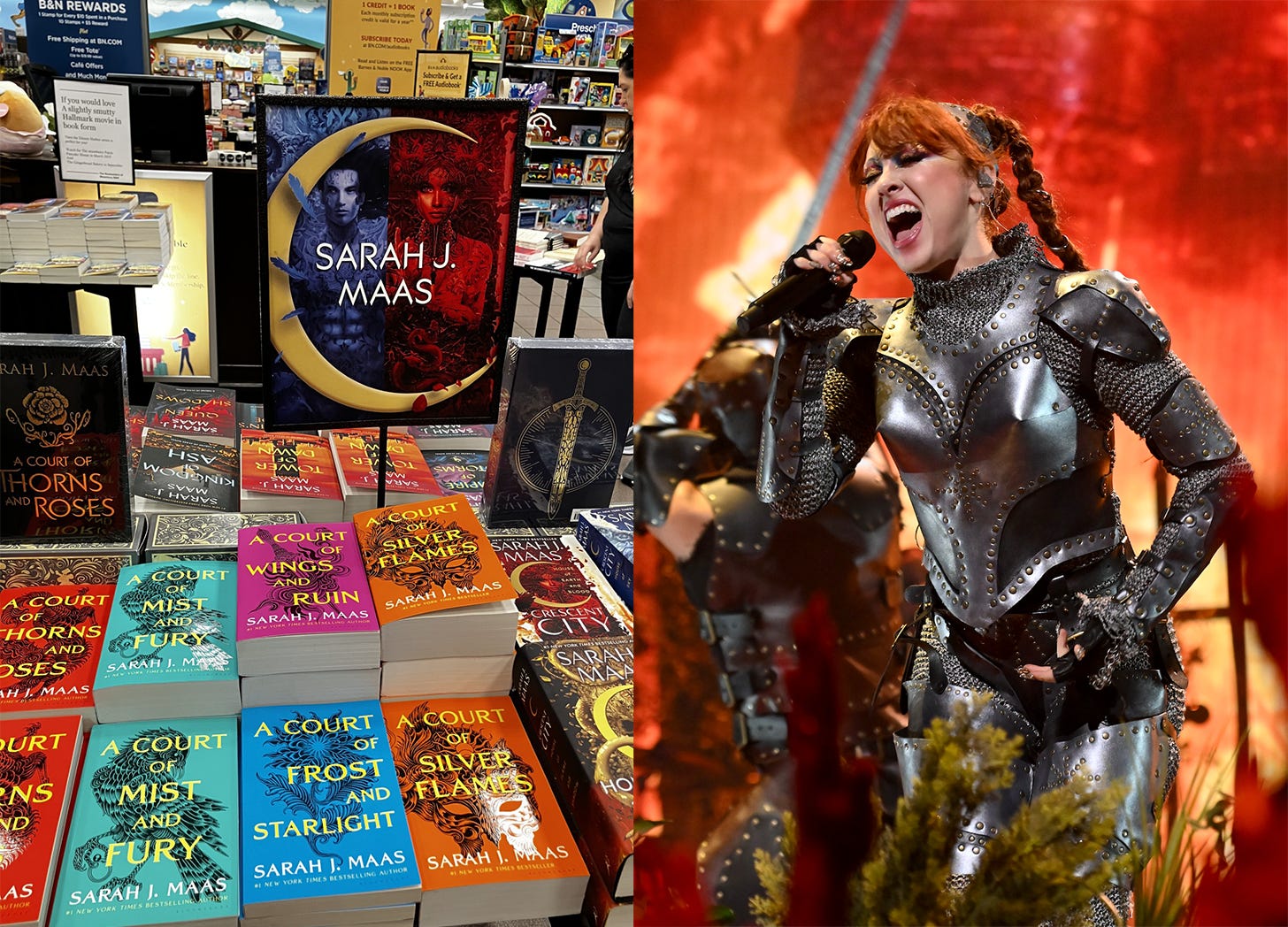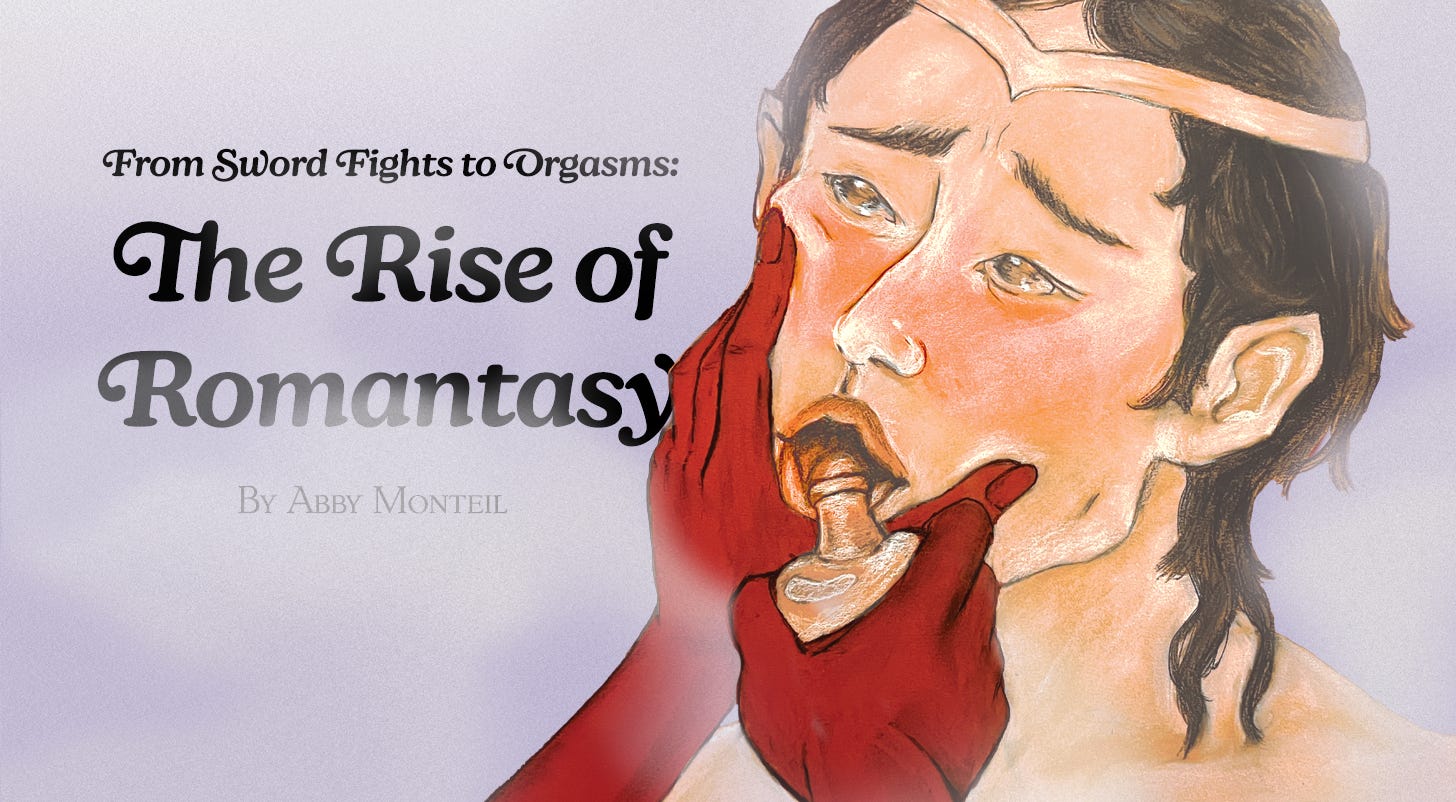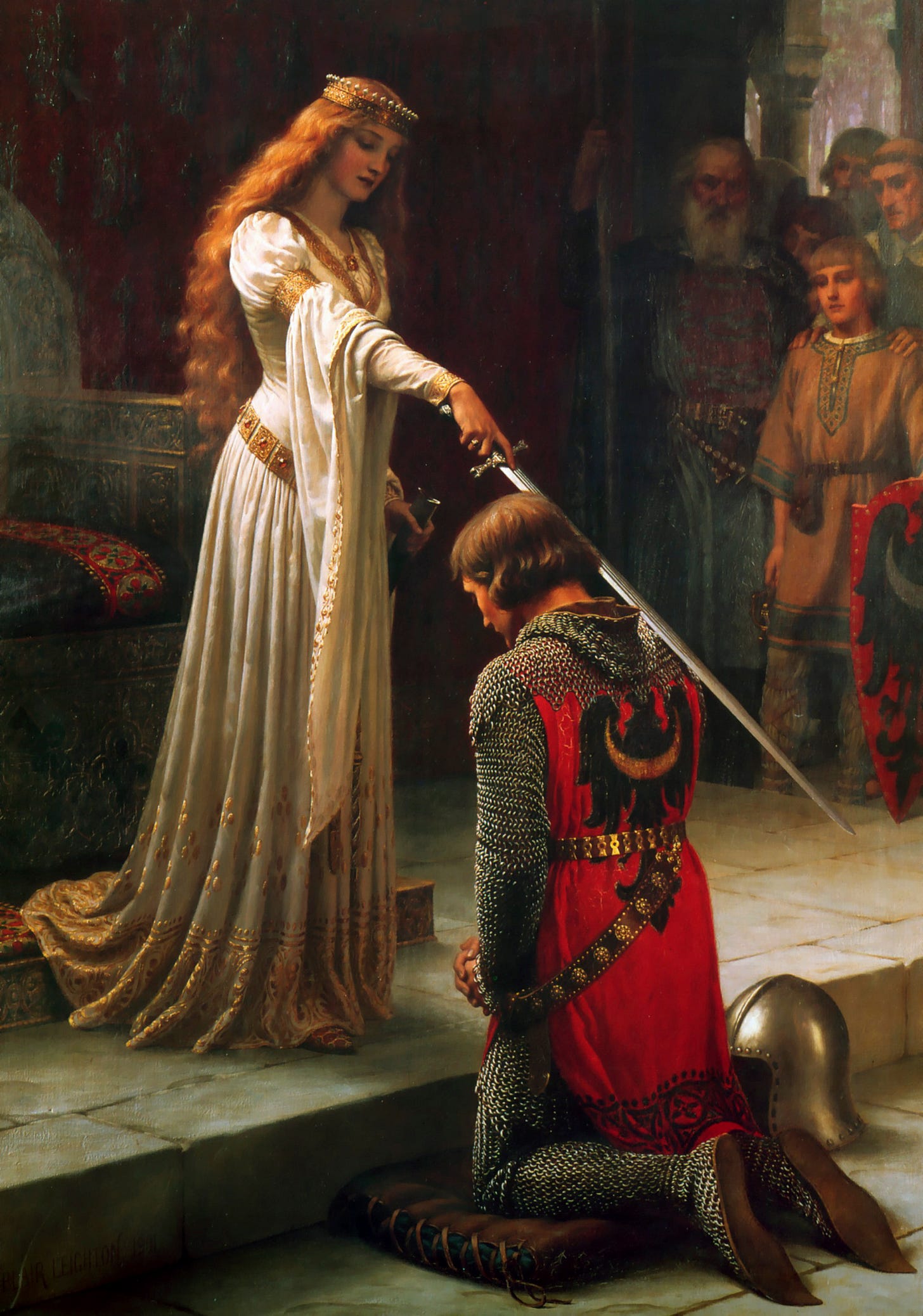From Sword Fights to Orgasms: The Rise of Romantasy
The subgenre offers a respite from reality that romance books set in the real world can’t necessarily pull off anymore.
To celebrate the launch of The Medievalist, our first print issue, we’re publishing a selection of stories from the magazine, plus a few newsletter-only additions, for all of you wenches to enjoy. Today, culture writer Abby Monteil explores the meteoric rise of the “romantasy” and how it’s the perfect escape from our current sociopolitical climate. The Medievalist is available for purchase online, now!
There’s no shortage of magic spells, epic quests, and fire-breathing dragons in canonical medieval and fantasy texts, but today’s successful takes on the genre add what we’ve always wanted most: more female orgasms.
“Romantasy” — a combination of “romance” and “fantasy” — is the wildly popular literary subgenre that’s currently dominating publishing. Contrary to what the squeaky-clean worlds of fantasy juggernauts like Lord of the Rings or Harry Potter might suggest, romantic, sexy elements are anything but new in fantasy storytelling. Yet amid the social turmoil of 2025, many readers have turned to romantasy not only for pleasurable escapism, but for a way to reckon with our precarious new reality.
Head into any bookstore, and you’re bound to spy copies of romantasy fan-favorites like A Court of Thorns and Roses, Fourth Wing, and The Cruel Prince lined up, front and center. Unlike traditional fantasy, which may have romantic subplots, romantasy usually splits the story 50/50: Half fantasy, half romance. Odds are, a young heroine fights against an oppressive regime and winds up falling for (and having really great sex with) a love interest whose relationship with her quite literally has international implications.
“It’s no longer enough to escape into a small-town romance where somebody owns a cupcake shop, because you know that the tariffs are going to eff up their business and all the workers are going to get kidnapped by ICE.”
The romantasy formula is paying off in spades — consumer analyst Circana projected that romantasy sales will reach $610 million this year. On TikTok, where BookTok devotees have embraced it in droves, the hashtag #romantasy has been used in over 1.3M posts. These days, the subgenre offers a respite from reality that romance books set in the real world can’t necessarily pull off anymore.
“It’s no longer enough to escape into a small-town romance where somebody owns a cupcake shop, because you know that the tariffs are going to eff up their business and all the workers are going to get kidnapped by ICE,” Leah Koch, co-owner of the romance bookstore The Ripped Bodice, says. “I think people want nothing of our disastrous world, and the only way to achieve that is to go to a completely different planet.”
Romantasy books may take place in other worlds, but many of the most popular ones are undeniably inspired by the castles, feudal unrest, and fairytale maximalism of medieval Europe — or, more accurately, how we imagine medieval times nowadays. It doesn’t feel coincidental that the romantasy boom has paralleled the rise of viral internet trends like “medievalcore” and “castlecore,” both of which showed up on Pinterest’s 2025 trend predictions report. From Chappell Roan’s Joan of Arc-esque VMAs performance to Renaissance Faires’ soaring attendance numbers, many of us are clearly craving ye olden days — or at least what we imagine it to be.

Medievalist David Matthews theorized that medievalism has two sides: One focuses on the romance associated with the period (think: damsels in distress and chivalry), a tradition that romantasy has helped update for the standards of the 2020s. The flip side captures the grotesqueness of medieval times, with its plagues and widespread violence. Megan Cook, a medievalist and associate English professor at Colby College, theorizes that when we reach for medieval aesthetics in our books and beyond, we’re also searching for ways to reckon with our own uncertain world.
“I think a lot of us [in the U.S.] are feeling like we are being unwillingly thrust into something that feels, in certain ways, medieval,” Cole says. “Rigidly defined gender roles, really strong policing of cultural norms around race and ethnicity and religion, a kind of totalitarian vibe going on. You can read [this medieval revival] as, ‘Well, if we’ve gotten to this part of [medieval times], I want a pretty hat, too.’”
Medieval revivals have popped up over and over again during times of social upheaval and innovation, from ‘60s and ‘70s youth culture to the Harlem Renaissance. But because our cultural understanding of the Medieval Era is more vibes-based than many other periods in history, it has also been appropriated by right-wing movements. When white nationalists gathered for 2017’s “unite the right” rally in Charlottesville, for example, photos of them carrying shields went viral. During a time when fascism is on the rise around the world, the capable heroines of romantasy often leave less room for questioning authorial intent.
And let’s face it — setting a romance within a fantasy world can imbue your story with delicious, high-stakes tension that you wouldn’t necessarily find in, say, a coffee shop setting. In these scenarios, finally having great sex with your situationship can feel just as meaningful as saving your kingdom from all-powerful forces of darkness.
“One thing that really appeals to people with romantasy is that the romance itself can be so much bigger,” romantasy author Nisha J. Tuli says. “[There are] world-ending stakes around them being in love. Like, ‘If we don’t bang, the world will end’... I think people really enjoy the depth of where you can go with [the main relationship] in a romantasy that you can’t really go in other genres.”
Romantasy’s otherworldly settings also give readers permission to explore their own sexual desires in a safe, escapist context. While some older fantasy stories objectify their female characters or put them through gratuitous sexual trauma, romantasy stories, at their best, present female leads whose sexual and narrative agency are both taken seriously.
Reading about armored heroines taking on empires of villainous patriarchs often feels like a pointed counterpoint to the bro-y technofeudalism of billionaires like Elon Musk, who feel emboldened to champion extreme wealth inequality and a rollback of reproductive rights.
“I don’t think people are saying, ‘Oh, I feel like a [peasant] and I’m gonna work happily for my corporate overlord for the rest of my career,’” Cook says. “The peasants eventually did revolt. I think we’re identifying with a version of that.”
Less successful is mainstream romantasy’s inclusion of queer characters and characters of color. Like many publishing trends, the medievalism of romantasy skews overwhelmingly straight and white (Sarah J. Maas, arguably the most popular romantasy author in the world, has faced criticism for invoking Breonna Taylor during a promotional Instagram post). Ironically, one of the earliest romantasy stories — the 13th century French poem Le Roman de Silence — features an openly genderqueer protagonist.
Tuli based her BookTok-famous series Trial of the Sun Queen on her Indian heritage. Her other series, The Nightfire Quartet, intentionally challenges reader perceptions about what a fantasy story can be by placing characters of color within a Euro-centric world, “because some people cannot wrap their heads around that,” she says.
Cook corroborates the need to continue reinventing within the genre. “I think there’s a real hunger for [individual, personal art] that lines up really well with what we’ve seen from other medieval revivals,” Cook adds.
Hopefully, this romantasy boom will help even more readers see themselves in new worlds — ideally with more pleasure and less peasantry.
Abby Monteil is a culture writer who lives in Chicago with her cats Betty and Josie. Her work can also be found in Them, Rolling Stone, The Daily Beast, Slate, Marie Claire, and more. What she did in Sims 3 is not reflective of her overall character.





I would love to see different worlds and cultures represented in both romantasies and conventional fantasies. The medieval European setting feels a bit overdone at this point, and there's so much else to explore.